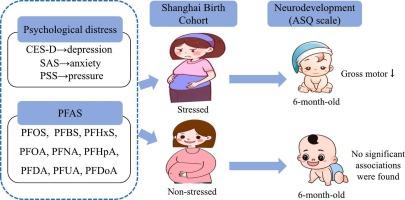母亲的心理困扰改变了产前暴露于全氟烷基和多氟烷基物质与婴儿神经发育之间的关系
IF 8
1区 环境科学与生态学
Q1 ENVIRONMENTAL SCIENCES
引用次数: 0
摘要
产前PFAS暴露和母亲心理困扰可能通过共同的生物学途径对儿童神经发育产生不利影响,如下丘脑-垂体-肾上腺(HPA)轴破坏和促炎反应。然而,心理困扰是否会改变pfas相关的神经发育风险仍不清楚。使用来自上海出生队列的数据,包括1779对母婴,我们测量了孕早期产妇的PFAS水平,并评估了孕中期产妇的心理困扰(感知压力、抑郁和焦虑)。在6个月大时使用Ages &;阶段问卷-第三版(ASQ-3)。采用多变量回归模型和分位数g计算来评估ASQ-3评分与单独和混合PFAS的关系。对心理困扰积极组(经历过任何一种压力源)和消极组(没有经历过任何压力源)进行分层分析。我们发现,41%的孕妇至少经历过一种心理困扰。在所有参与者中,母亲PFAS暴露与儿童大运动得分降低有关。母亲的心理困扰状态改变了PFAS与大运动评分之间的关系。具体而言,PFAS与大运动发育的不良关联仅在心理困扰阳性组中观察到,而在心理困扰阴性组中未发现相关。产妇心理困扰与大多数PFAS化合物之间存在显著的交互作用(交互作用P均为<;0.1)。此外,在经历多种心理压力源的妇女中,产前PFAS暴露与大运动发育的不良关联加剧。本研究表明,母亲的心理困扰可能会增加6个月大儿童发生与pfas相关的不良大动作发育的风险。调查产妇的心理困扰可能是识别弱势群体和指导干预措施的关键。本文章由计算机程序翻译,如有差异,请以英文原文为准。

Maternal psychological distress modifies the association between prenatal exposure to per- and polyfluoroalkyl substances and infants' neurodevelopment
Prenatal PFAS exposure and maternal psychological distress may adversely affect child neurodevelopment through shared biological pathways, such as hypothalamic-pituitary-adrenal (HPA) axis disruption and pro-inflammatory responses. However, whether psychological distress modifies PFAS-related neurodevelopmental risks remains unclear. Using data from the Shanghai Birth Cohort including 1779 mother-child pairs, we measured maternal PFAS levels during the first trimester and assessed maternal psychological distress (perceived stress, depression, and anxiety) during the second trimester. Child neurodevelopment was evaluated at 6 months of age using the Ages & Stages Questionnaires-Third Edition (ASQ-3). Multivariable regression models and quantile g-computation were conducted to evaluate the associations of ASQ-3 scores with individual and mixture PFAS. Stratified analyses were conducted between the psychological distress positive group (experienced any one type of stressor) and negative group (experienced no stressors). We found that 41 % of pregnant women experienced at least one type of psychological distress. Among the overall participants, maternal PFAS exposure was associated with reduced gross motor scores in children. Maternal psychological distress status modified the association between PFAS and gross motor scores. Specifically, the adverse associations of PFAS with gross motor development were only observed in the psychological distress positive group, while no association was found in the negative group. Significant interaction effects were observed between maternal psychological distress and most PFAS compounds (all P for interaction <0.1). Furthermore, the adverse associations of prenatal PFAS exposure with gross motor development intensified in women experiencing multiple types of psychological stressors. This study indicates that maternal psychological distress may increase the risk of PFAS-related adverse gross motor development in six-month-old children. Investigating maternal psychological distress could be crucial for identifying vulnerable populations and guiding intervention measures.
求助全文
通过发布文献求助,成功后即可免费获取论文全文。
去求助
来源期刊

Science of the Total Environment
环境科学-环境科学
CiteScore
17.60
自引率
10.20%
发文量
8726
审稿时长
2.4 months
期刊介绍:
The Science of the Total Environment is an international journal dedicated to scientific research on the environment and its interaction with humanity. It covers a wide range of disciplines and seeks to publish innovative, hypothesis-driven, and impactful research that explores the entire environment, including the atmosphere, lithosphere, hydrosphere, biosphere, and anthroposphere.
The journal's updated Aims & Scope emphasizes the importance of interdisciplinary environmental research with broad impact. Priority is given to studies that advance fundamental understanding and explore the interconnectedness of multiple environmental spheres. Field studies are preferred, while laboratory experiments must demonstrate significant methodological advancements or mechanistic insights with direct relevance to the environment.
 求助内容:
求助内容: 应助结果提醒方式:
应助结果提醒方式:


